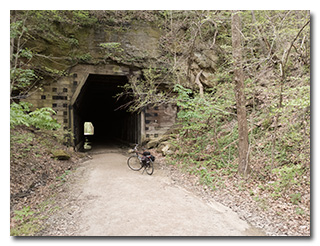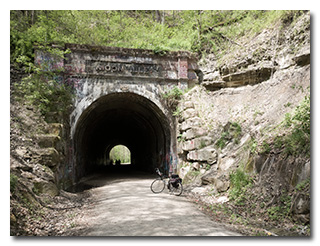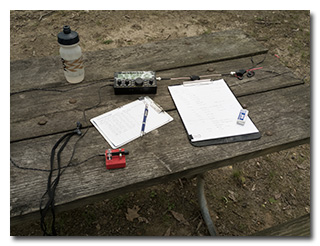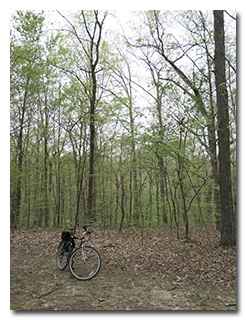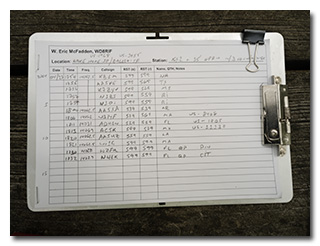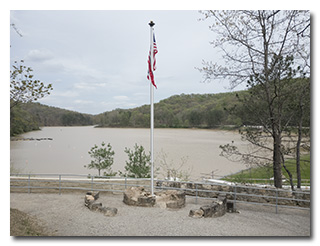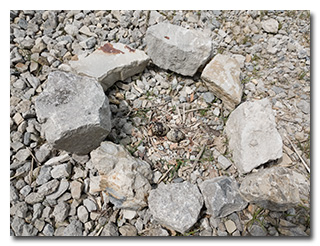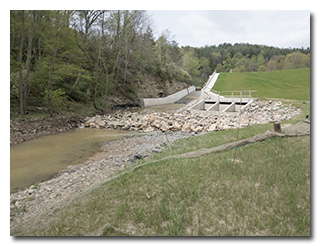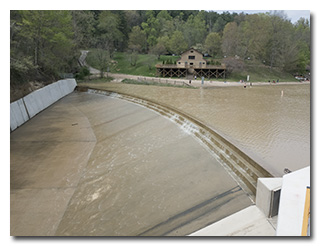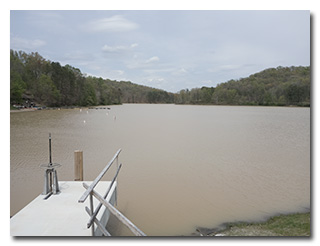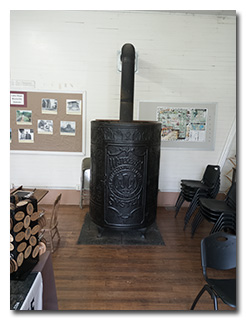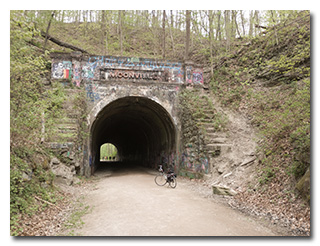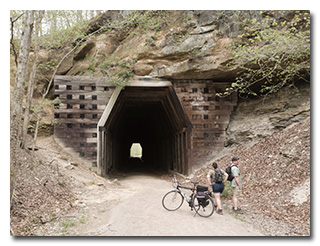
by William Eric McFadden
From the Moonville Rail Trail website:
-
This 10-mile rail trail takes visitors through the beautiful woodlands of southeast Ohio, including Zaleski State Forest; the communities of Zaleski and Mineral; and the Lake Hope State Park wetland areas. The corridor holds water on both sides of the trail, creating a wetland area that is home to numerous species of flora and fauna.
Additional points of interest along this trail are two unique and historic tunnels. King’s Hollow Tunnel (also known as King Switch Tunnel) is a 120-foot structure carved through the rock and lined by a series of 12x12 wooden beams. The Moonville Tunnel is brick-lined and has a long history of train accidents, earning the tunnel a reputation for being haunted.
From the Lake Hope State Park website:
-
Though the roar of the iron furnaces no longer echoes through the hills of Vinton County, there are many reminders of days gone by at Lake Hope State Park. Situated at the northern edge of Ohio's Hanging Rock iron region, the park reflects the rich history of southeastern Ohio's industrial past. Built in 1853-54, the Hope Furnace processed the iron ore extracted from the region’s sandstone bedrock. The iron resulting from the ore smelting process was used to produce many different items including ammunition and cannons for the Union Army during the Civil War. Hundreds of men labored, cutting timber, working the furnace, and driving teams of oxen hauling iron ore to the furnace. Charcoal fires, needed to fuel the furnace, were tended 24 hours a day. So much wood was required for this process that the surrounding hillsides were almost completely stripped of their timber.
At the height of the Hope Furnace’s production, Ohio was one of the nation’s leading producers of iron. As time passed, iron ore was discovered farther west, and Ohio’s reputation as a major iron producer waned. The Hope Furnace shut down in 1874, after only 20 years of operation. By 1900, nearly all the major furnaces in southern Ohio were shut down. Today, the Hope Furnace chimney and some of the foundation are all that remain of the structure. Near the chimney, one may find pieces of slag, the cast-off residue from the smelting process. These pock-marked, glass-like pieces have now become a part of the forest floor.
The forest we now see is one that has grown back in place of the primeval forest that once stood hundreds of years ago. For a time, coal was an important Vinton County export. Many mines tunneled into the hills and large quantities of coal were transported out utilizing ox-drawn coal cars, and later the railroad. Most of the mines were abandoned early in the 20th century. Lake Hope Forest Park was created in 1937 by the Division of Forestry. The lands became Lake Hope State Park in 1949 when the Ohio Department of Natural Resources was created.
From the Zaleski State Forest website:
-
The 27,822-acre Zaleski State Forest is the second largest forest in Ohio's system of state forests.
Zaleski State Forest operates the only state-owned sawmill in Ohio. The mill produces rough sawn lumber for use by Ohio’s state forests and state parks as well as other government agencies.
Historic Moonville Tunnel is located within Zaleski State Forest on the Moonville Rail Trail right-of-way.
Pictures
- Outbound: King's Hollow Tunnel | Moonville Tunnel
- Eric's KX2 station
- Eric's bicycle-supported mast and antenna
- Eric's log
- The new Lake Hope overlook
- A Killdeer nest
- The new dam: 1 | 2
- Lake Hope as viewed from atop the new dam
- The humongous wood stove in Hope Schoolhouse
- Inbound: Moonville Tunnel | King's Tunnel
Description
On Saturday, April 27, 2024, one member of the Southeast Ohio Radio Adventure Team performed a successful bicycle-portable simultaneous activation of Lake Hope State Park (US-1968) and Zaleski State Forest (US-5455) in Ohio as part of the Parks on the Air (POTA; link) program.
Because it was Rails-to-Trails Conservancy's Celebrate Trail Day, Eric McFadden, WD8RIF, bicycled Moonville Rail Trail from Mineral to Lake Hope State Park to perform the two-fer activation.
Eric started his ride from Mineral at 1647 UTC when the temperature was 77° and the winds were blowing at 15 mph and gusting to 22 mph. Despite the wind, the ride west along the smooth gravel Moonville Rail Trail was pleasant and easy. Eric passed over many bridges and through the King's Hollow Tunnel and the Moonville Tunnel. The rail trail still missing two bridges beyond Moonville Tunnel, Eric was forced to detour on the hilly, rough, gravel, Hope Moonville Road for about a mile before rejoining the Moonville Rail Trail. Upon reaching the intersection with Wheelabout Road, Eric left the Moonville Rail Trail for a quick visit to the Hope Schoolhouse, and then rode the short distance on roads to the Lake Hope State Park entrance.
Eric hadn't decided before his arrival where exactly he wanted to set up his station and operate, but upon reaching the park, he decided to climb the long hill up to Keeton Cemetery and to use the picnic table and the cell-signal available there for this operation.
Eric arrived at Keeton Cemetery at 1740 UTC and found the single picnic table to be available. He quickly set up his Elecraft KX2 on the picnic table, erected his Goture Red Fox Super Hard 720 carbon-fiber mast on his bicycle, sloped his Tufteln (link) 35' EFRW antenna from the KX2 up to top of the mast, and deployed three 17' counterpoise wires directly on the ground. Eric was on the air at 1752 UTC.
As he had hoped, Eric found he had good cell-signal at this location and he would be able to spot himself on the POTA Spots website (link) and to use POTA Spots to identify possible Park-to-Park (P2P) QSOs.
Eric began his operation on 20m, finding himself a clear frequency well above the Florida QSO Party activity, calling "CQ POTA", and was auto-spotted on POTA Spots. His first QSO came at 1754 UTC with KB1M in New Hampshire. QSOs came steadily, with Eric's sixth QSO coming at 1800 UTC with AA5XA. This run included QSOs with operators located in New Hampshire, Texas, Mississippi, Rhode Island (2), and Arkansas.
When replies to his calls on 20m seemed to dry up, Eric consulted POTA Spots in hopes of making P2P QSOs. At 1806 UTC he made a P2P QSO on 20m with W3PYF who was activating Elm Bank State Reserve (US-8408) in Massachusetts. At 1811 UTC he made a P2P QSO on 20m with AD4GN who was activating North Peninsula State Park (US-1905) in Florida. Finally, at 1813 UTC he made a P2P QSO on 20m with AC5K who was activating Roaring River State Conservation Area (US-11138) in Missouri. Eric was unable to work any of the activators that were spotted on 40m, even those who would normally be well within his propagation footprint.
Returning to run a frequency on 20m, Eric made two more QSOs. At 1820 UTC he made a QSO with stalwart hunter AA5UZ in Louisiana, and at 1821 UTC he made a QSO with WI1G in Massachusetts.
Eric finished his operation by tuning to the low end of the 20m band and working a pair of Florida-based operators participating in the Florida QSO Party. At 1830 UTC he worked W2FU in Pinellas County, and at 1932 UTC, he worked N4EK in Citrus County.
In all, Eric logged thirteen QSOs, with three P2P QSOs, in forty minutes of air time. All of Eric's QSOs were CW and were made at five watts output.
After packing up his station and loading his bicycle, Eric began his ride back east to Mineral and his car, but first did a little bit of exploring of Lake Hope's new dam, and he returned to the Hope Schoolhouse for a quick tour of the museum and gift shop. For his ride back to Mineral, the temperature had risen slightly to 80° but the winds remained blustery at 15 mph gusting to 21 mph.
Eric also submitted his log to the World Wide Flora and Fauna in Amateur Radio (WWFF; link) program for an operation at Strouds Run State Park, KFF-1994.
(return)
